╔
La visibilidad de las mujeres en los puertos españoles sigue siendo poca y desigual
Dar visibilidad a las oportunidades profesionales que ofrece el sector y acabar con los estereotipos, retos para garantizar el relevo generacional en los puertos
Promoting the professional opportunities offered by the industry and eliminating stereotypes, challenges to ensure generational transition in ports
La presencia de la mujer en el sector de la logística y el transporte en España ha aumentado en los últimos años, es innegable, pero todavía está lejos de las marcas alcanzadas en otras áreas de actividad económica. Mientras la media nacional de presencia femenina es del 47,3%, en el sector logístico-portuario apenas se alcanza el 22%.
Esta realidad no es sólo palpable en España, a nivel europeo, el dato es similar. “El sector de la logística y el transporte da empleo a más de 11 millones de personas en Europa y, sin embargo, la mujer ocupa tan sólo el 22% de estos puestos”, confirma Mariló Peris, cofundadora y directora de Foro de Logística.
“Donde menor presencia de la mujer hay en el sector logístico es en el transporte terrestre, muy por debajo de la media del sector, con un 13,9 % de presencia”, detalla Peris, “donde mayor presencia de la mujer hay es en el transporte aéreo, con un 41,8%, aproximándose a la media nacional”.
The presence of women in the logistics and transport industry in Spain has increased in recent years, it is undeniable, but it is still far from the levels achieved in other areas of economic activity. Whereas the national average of female representation is 47.3%, in the logistics-port business it barely reaches 22%.
This reality is not only tangible in Spain; at European level, the data is very similar. “The logistics and transport industry employs over 11 million people in Europe, yet women occupy only 22% of these positions”, confirms Mariló Peris, co-founder, and director of Foro de Logística.
“The lowest proportion of women in the area of logistics is in road transport, well below the industry average, with a 13.9% presence”, Peris details, “whereas there is a greater representation of women in air transport, with 41.8%, close to the national average”.
Hoy en día no existe ninguna barrera para acceder a la profesión de portuaria, aunque el desconocimiento del sector portuario y de la propia profesión dificultan el acceso de mujeres. (Foto: Coordinadora Estatal de Trabajadores del Mar).
There is currently no barrier to access to the port profession, although the lack of knowledge of the port sector and the profession itself makes it difficult for women to enter. (Photo: Coordinadora Estatal de Trabajadores del Mar).
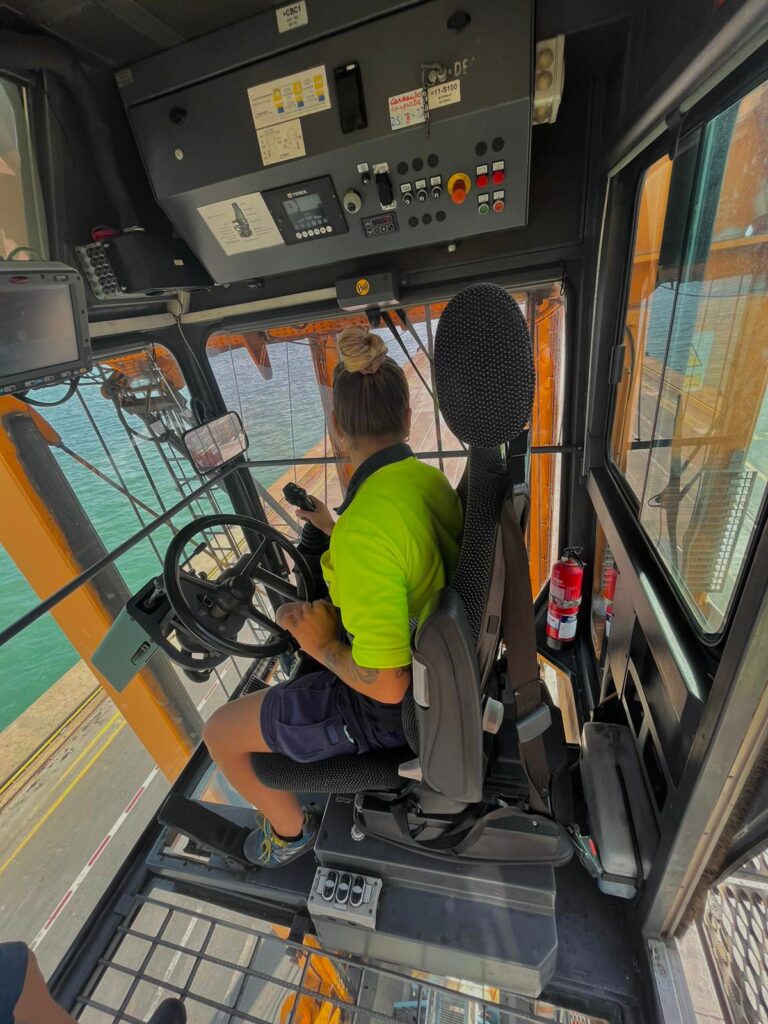
Pero ¿qué pasa en los puertos españoles? Lo cierto es que es muy difícil cuantificar la presencia de la mujer en las actividades portuarias que incluyen a profesionales de autoridades portuarias, terminales, almacenes, depósitos, talleres, amarradores, prácticos, seguridad, agencias, peritos, consultores, administración, marinos, etc. No existe ningún organismo que contabilice el acceso a las profesionales logísticas disgregando por género, no obstante, “en Puertos del Estado y los puertos españoles estamos comprometidos con la igualdad, la conciliación y la inclusión, como objetivos generales que se incluyen en el Marco Estratégico del sistema portuario de titularidad estatal”, comenta Álvaro Rodríguez Dapena, presidente del ente público Puertos del Estado.
But what is happening in Spanish ports? The truth is that it is very difficult to quantify the presence of women in port activities that include professionals from port authorities, terminals, warehouses, depots, yards, mooring, pilots, security, agencies, experts, consultants, administration, seafarers, etc. There is no entity that counts access to logistics professionals broken down by gender, however, “in Puertos del Estado and Spanish ports we are committed to equality, conciliation and inclusion, as general objectives included in the Strategic Framework of the state-owned port system”, says Alvaro Rodriguez Dapena, President of the public entity Puertos del Estado.
Álvaro Rodríguez Dapena, presidente del ente público Puertos del Estado. (Foto: Diario del Puerto).
Álvaro Rodríguez Dapena, President of the public entity Puertos del Estado. (Photo: Diario del Puerto).
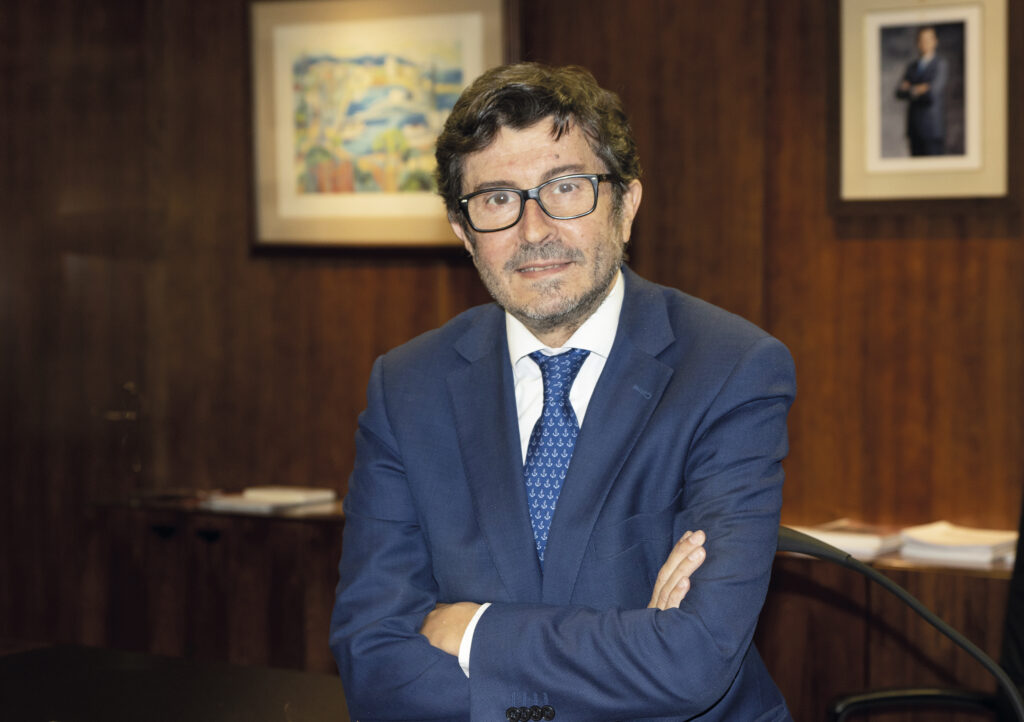
De hecho, una de las metas cuantitativas del mencionado Marco Estratégico es la paridad por género del sistema portuario equilibrada en todos los niveles, con horizonte en 2030. “En Puertos del Estado ya hemos alcanzado la paridad, con un 50% de mujeres y hombres en nuestro equipo. Esto no solo refleja nuestro compromiso con la igualdad de género, sino que también establece un modelo para todo el sector logístico-portuario donde todavía queda mucho por hacer en este terreno”.
No obstante, los últimos datos disponibles de Puertos del Estado, a 31 de diciembre de 2022, señalan que en las autoridades portuarias trabajan 3.545 hombres (73%) y 1.266 mujeres (26%). Eso sí, como apuntaba Rodríguez Dapena, en Puertos del Estado las cifras se equilibran ya que hay 69 hombres (50%) y 68 mujeres (50%).
Por ello, “seguimos trabajando para fomentar un ambiente que no sólo apoye la igualdad de oportunidades, sino que también facilite la conciliación laboral y familiar. Estas acciones son fundamentales para construir un sistema portuario que sea líder en eficiencia y competitividad, pero también en prácticas laborales justas y equitativas”, asevera el presidente de Puertos del Estado.
“Es imprescindible que sigamos avanzando en este camino, no sólo para cumplir con nuestros objetivos estratégicos, sino para garantizar que los puertos españoles sean ejemplares en materia de inclusión y diversidad, que sean en todos los aspectos unos puertos por y para las personas”, insiste Rodríguez Dapena.
In fact, one of the quantitative targets of the mentioned Strategic Framework is gender parity in the port system balanced at all levels, with a horizon of 2030. “In Puertos del Estado we have already achieved parity, with 50% of women and men in our team. This not only reflects our commitment to gender equality, but also sets a model for the entire port-logistics sector where there is still much to be done in this area”.
Nevertheless, the latest data available from Puertos del Estado, as of December 31, 2022, show that 3,545 men (73%) and 1,266 women (26%) work in the port authorities. However, as Rodríguez Dapena pointed out, in Puertos del Estado the figures are balanced since there are 69 men (50%) and 68 women (50%).
Therefore, “we continue working to promote an environment that not only supports equal opportunities, but also facilitates work and family reconciliation. These actions are essential to build a port system that is leader in efficiency and competitiveness, but also in fair and equitable labor practices”, says the President of Puertos del Estado.
“It is imperative that we continue to move forward on this path, not only to meet our strategic goals, but also to ensure that Spanish ports are role models in terms of inclusion and diversity, that they are in all areas ports by and for people”, said Rodriguez Dapena.
Puestos directivos
Management Positions
En el escenario portuario más vinculado con la dirección y gestión de las autoridades portuarias, dos apuntes que ejemplifican como el camino se ha iniciado, pero todavía queda mucho por hacer.
El primero: el sistema portuario español cuenta con 28 autoridades portuarias (AP), pero tan sólo cuatro de las entidades están presididas por mujeres (Rosario Soto, presidenta de la AP de Almería; Teófila Martínez, presidenta de la AP de la Bahía de Cádiz; Beatriz Calzada, presidenta de la AP de Las Palmas y Mar Chao, presidenta de la AP de Valencia).
Y el segundo: de las 28 autoridades portuarias solo dos incluyen en sus organigramas a mujeres al frente de las áreas de Dirección. En concreto son la Autoridad Portuaria de Vigo, cuya directora es Beatriz Colunga, y la Autoridad Portuaria de Vilagarcía de Arousa, cuya directora es Begoña Mesejo.
“Cuando son puestos de libre designación o por nombramiento, como es el caso de las presidencias, hay que hacer un esfuerzo desde la administración pública para aprovechar la oportunidad de visualizar la presencia femenina en cargos de responsabilidad como estos; y cuando son puestos con convocatorias públicas, tenemos que tener la capacidad de hacerlos lo suficientemente atractivos para atraer el talento femenino”, reconoce Teófila Martínez, presidenta de la Autoridad Portuaria de la Bahía de Cádiz y de RETE.
Within the port context more closely tied to the administration and management of port authorities, two notes that highlight how the path has begun, but there is still a long way to go.
The first: the Spanish port system has 28 port authorities (PA), but only four of them are presided by women (Rosario Soto, President of the Almeria PA; Teófila Martínez, President of the Bay of Cadiz PA; Beatriz Calzada, President of the Las Palmas PA and Mar Chao, President of the Valencia PA).
And the second: of the 28 port authorities, only two include women in their organizational charts at the head of the management areas. These are the Port Authority of Vigo, whose director is Beatriz Colunga, and the Port Authority of Vilagarcía de Arousa, whose director is Begoña Mesejo.
“When these are positions of free designation or by appointment, as is the case of the presidencies, we have to make an effort from the public administration to take advantage of the opportunity to visualize the female presence in positions of responsibility such as these; and when these are positions with public convocations, we have to have the capacity to make them attractive enough to attract female talent”, recognizes Teófila Martínez, President of the Port Authority of the Bay of Cadiz and of RETE.
Teófila Martínez, presidenta de la Autoridad Portuaria de la Bahía de Cádiz y de RETE. (Foto: Autoridad Portuaria de la Bahía de Cádiz).
Teófila Martínez, President of the Port Authority of the Bay of Cadiz and RETE. (Photo: Port Authority of the Bay of Cadiz).
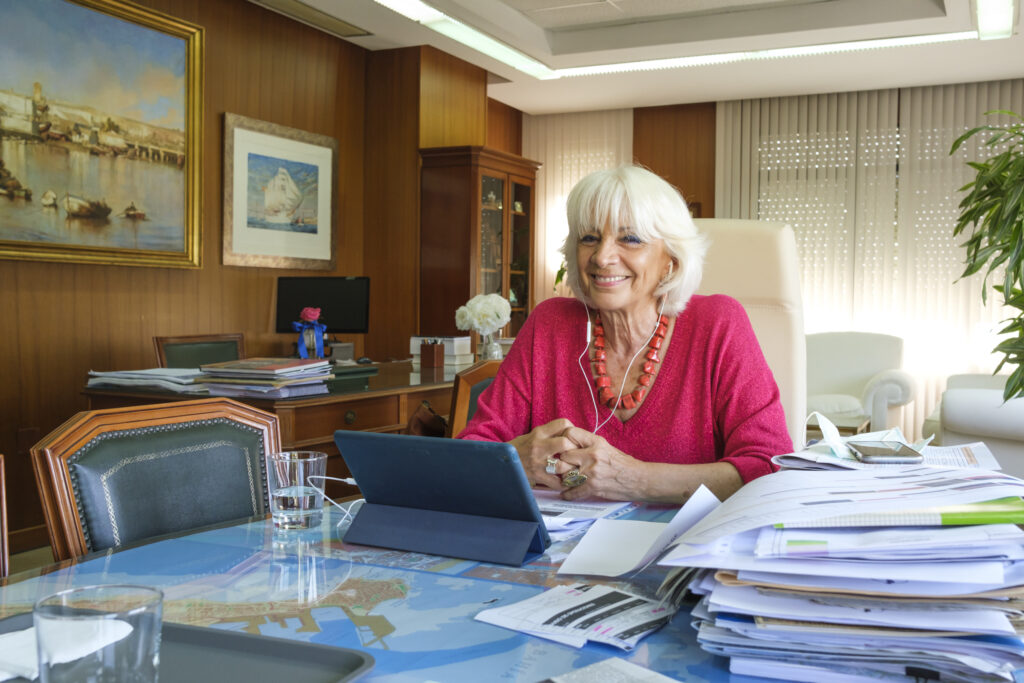
Es fundamental la divulgación y la información, apunta, para que sea una alternativa real sobre todo en los centros de formación profesional y en las universidades. “Nosotros estamos haciendo un importante esfuerzo de hacer foros sobre el papel de la mujer en la industria de cruceros y en el sector en general y comprobamos que hay un número importante de mujeres que participan”, afirma Martínez.
Dissemination and information is essential, she points out, so that it becomes a real alternative, especially in vocational training centers and universities. “We are making an important effort to hold forums on the role of women in the cruise industry and in the industry in general, and we are finding that a significant number of women are participating”, says Martínez.
Buscando el foco
Searching for the Spotlight
Rosana Velasco, presidenta de WISTA Spain, rama nacional de WISTA International (Women’s International Shipping and Trading Association), se suma al análisis recordando que la visibilidad de la mujer, especialmente en cargos directivos, sigue siendo escasa. “El sector portuario, en general, sigue siendo un mundo con presencia mayoritariamente masculina que se pone de manifiesto tanto en reuniones de alto nivel, donde difícilmente encontraras a más de una mujer, y, sobre todo, en los foros de difusión (conferencias, foros, mesas redondas, etc.) y en las noticias. No se busca expertas femeninas ¡y existen! Es verdad que son menos y que hay que hacer mayor trabajo para encontrarlas, pero las hay”, insiste Velasco.
En este escenario, “¿puede el sector seguir permitiéndose renunciar al talento profesional femenino, actualmente desaprovechado? La respuesta es no. El desarrollo social, en educación, y de las nuevas tecnologías y desarrollo industrial, ayudan mucho, así como la fuerte demanda de fuerza de trabajo y profesionales que el sector tiene, pero no es aún suficiente para que podamos decir que estamos en términos de igualdad”, confirma la presidenta de WISTA.
“Debemos trabajar para asegurar que las mujeres tengan las mismas oportunidades, promoviendo la equidad y, a la vez, la eficiencia de nuestra economía”, expone Velasco, “yo soy fan de los equipos mixtos, la combinación de talentos y habilidades en equipos formados por hombres y mujeres demuestra que dan mejores resultados; y ello se traduce en una mejoría a nivel de dirección, de empresa, y al final, repercute en positivo en nuestra sociedad”.
Rosana Velasco, President of WISTA Spain, the national branch of WISTA International (Women’s International Shipping & Trading Association), adds to the analysis, recalling that the visibility of women, especially in management positions, is still low. “The port industry, in general, continues to be a world with a predominantly male presence, which is evident both in high-level meetings, where it is difficult to find more than one woman, and, above all, in dissemination forums (conferences, forums, round tables, etc.) and in the news. Female experts are not sought after, and they do exist! It is true that there are fewer of them and that more work must be done to find them, but they do exist”, insists Velasco.
Given this scenario, “can the industry continue to afford to miss out on female professional talent, which is currently underutilized? The answer is no. Social development, in education, and in new technologies and industrial development, help a lot, as well as the strong demand for workforce and professionals that the branch has, but it is still not enough for us to say that we are on equal terms”, confirms the President of WISTA.
“We should work to ensure that women have the same opportunities, promoting equity and, at the same time, the efficiency of our economy”, says Velasco, “I am a fan of mixed teams, the combination of talents and skills in teams formed by men and women shows that they give better results; and this translates into an improvement at the management and company level, and in the end, has a positive impact on our society”.
Rosana Velasco, presidenta de WISTA – Women’s International Shipping & Trading Association, Spain. (Foto: WISTA).
Rosana Velasco, President of WISTA – Women’s International Shipping & Trading Association, Spain. (Photo: WISTA).

A pie de muelle
At the Docks
Por otro lado, según los datos a los que tiene acceso la confederación sindical Coordinadora Estatal de Trabajadores del Mar, la estiba portuaria en España cuenta, en el 2024, con 719 mujeres, cifra que supone el 9,5% del total de profesionales estibadores en los puertos. Con respecto al año 2017, la presencia de las estibadoras se ha incrementado en 4 puntos, ya que en ese momento era del 5,5%. Actualmente, hay estibadoras en 19 puertos del Estado.
“Afortunadamente el acceso de mujeres al sector se ha acelerado exponencialmente en estos últimos años. El hecho de que la mayoría de las mercancías se hayan contenerizado y su manipulación sea mucho más mecanizada ha facilitado este aumento, a pesar de que sigue habiendo muchas tareas con una carga física importante, ya no son el 100% de las funciones”, explica Laia Marimon, responsable de la Comisión de Igualdad de Coordinadora Estatal de Trabajadores del Mar. Además, recuerda Marimon, “cada vez son más los Centros Portuarios de Empleo que cuentan con un Plan de Igualdad negociado con el Comité de Empresa, estas medidas seguro que han animado a más mujeres a formar parte de este sector”.
Asimismo, factores externos que se han dado los últimos 20 años, como son el cambio en la mentalidad sobre el papel de la mujer en la sociedad, la aceptación de la igualdad entre hombres y mujeres o la incorporación cada vez mayor de las mujeres en el mercado laboral, han facilitado el acceso de las mujeres en un sector tan masculinizado como es la estiba. “Es de destacar la visibilidad que se está dando a la mujer estibadora que ayuda a que otras mujeres vean el puerto y la estiba como una opción de trabajo”, reconoce la responsable de la Comisión de Igualdad de Coordinadora.
On the other hand, according to data to which the confederated union Coordinadora Estatal de Trabajadores del Mar has access, port stevedoring in Spain has, in 2024, 719 women, a figure that represents 9.5% of the total number of stevedoring professionals in the ports. With respect to 2017, the presence of female stevedores has increased by 4 points, since at that time it was 5.5%. Currently, there are female stevedores in 19 ports of the State.
“Fortunately, the access of women to the industry has accelerated exponentially in recent years. The fact that most of the goods have been containerized and their handling is much more mechanized has facilitated this increase, although there are still many tasks with a significant physical burden, they are no longer 100% of the functions”, explains Laia Marimon, Head of the Equality Commission of Coordinadora Estatal de Trabajadores del Mar. In addition, Marimon recalls, “more and more Port Employment Centers have an Equality Plan negotiated with the Works Committee, these measures have surely encouraged more women to join this industry”.
Also, external factors that have occurred in the last 20 years, such as the change in the mentality about the role of women in society, the acceptance of equality between men and women or the increasing incorporation of women in the labor market, have facilitated the access of women in a branch as masculinized as the stevedoring. “It is worth highlighting the visibility that is being given to female stevedores, which helps other women to see the port and stevedoring as a job option”, acknowledges the Head of Coordinadora’s Equality Commission.
Laia Marimon, responsable de la Comisión de Igualdad de Coordinadora Estatal de Trabajadores del Mar. (Foto: Coordinadora Estatal de Trabajadores del Mar).
Laia Marimon, Head of the Equality Commission of Coordinadora Estatal de Trabajadores del Mar. (Photo: Coordinadora Estatal de Trabajadores del Mar).
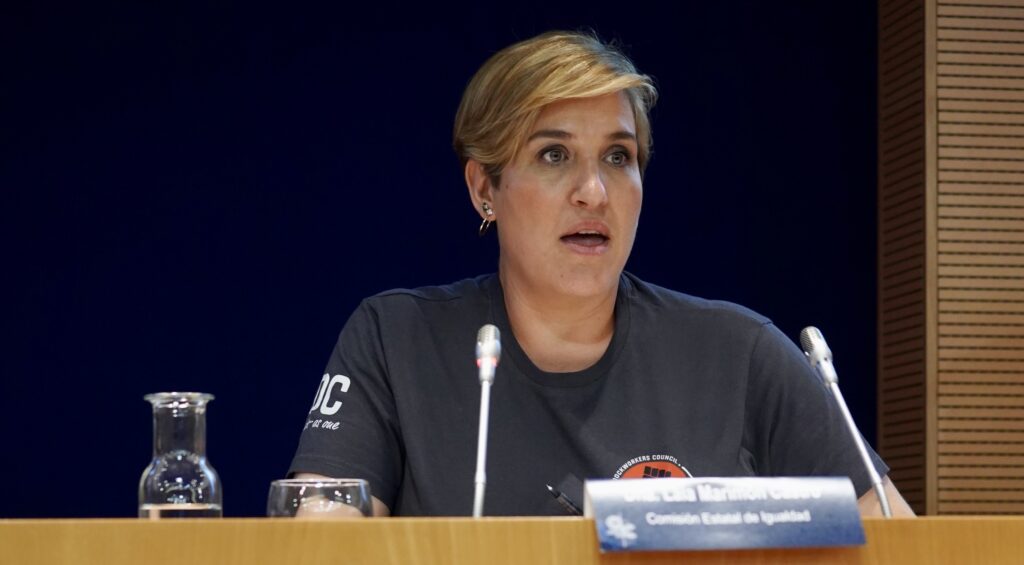
No hay límites, pero…
There are no limits, but…
Rosana Velasco, presidenta de WISTA Spain, lo tiene claro: “No hay límites en los roles que las mujeres pueden tener en el sector marítimo y con el apoyo mutuo y el espíritu de asociación somos más fuertes. Trabajando juntos impulsamos el camino hacia la igualdad de género y hacemos más visible y decisiva nuestra profesionalidad”. Pero, no hay que negar la realidad que viven muchas profesionales del sector.
En ocasiones, “los procesos de selección no son transparentes ni igualitarios. Aquí, los departamentos de Recursos Humanos tienen trabajo. Además, nos encontramos con organizaciones empresariales anticuadas que no dan las mismas oportunidades o confianza a las mujeres y una cultura masculinizada donde la mujer puede sentirse poco respaldada o insegura. En este sentido, los Planes de Igualdad internos deben ser efectivos y con seguimiento real. Las mujeres que llegan a puestos de dirección deben consolidarse y el entorno les debe dar las herramientas para ello”, añade.
Si no es así, si sigue habiendo más exigencias a las mujeres y paralización en el crecimiento profesional, “perderemos el talento”, alerta la presidenta de WISTA. “Se habla mucho de formación, acceso y promoción, pero no del talento femenino que abandona el sector. Una pérdida que no nos podemos permitir. Los motivos son muy variados, pero sabemos que hay profesiones de especial dificultad y/o dedicación y/o riesgo, y además el sector trabaja 24/7. Estas situaciones, si además no son gestionadas adecuadamente desde el punto de vista de la igualdad, solidaridad y conciliación pueden generar abandono”, subraya Velasco.
Por su parte, Teófila Martínez, presidenta de la Autoridad Portuaria de la Bahía de Cádiz y de RETE, explica que no le constan datos o estudios oficiales al respecto. “No existe una foto fija de la situación de la mujer en el sector marítimo portuario. Tenemos indicios, hay iniciativas deslavazadas puestas en marcha por el interés y el compromiso particular de determinadas instituciones, pero no existe un dato oficial que analice el sector en su conjunto. En el caso particular del Puerto de la Bahía de Cádiz hemos puesto en marcha el primer Plan de Igualdad, que ha conllevado un estudio de situación previo, donde hemos podido comprobar que hay una mayor incorporación de mujeres a la plantilla del puerto, también una mayor presencia de mujeres en puestos directivos, pero no sabemos cómo es esa evolución en la comunidad portuaria ni tampoco se han comparado esos datos con el de otros puertos”.
En el caso particular de la APBC, la evolución de la presencia de mujeres en la Autoridad Portuaria de la Bahía de Cádiz ha sido positiva en los últimos años, “si bien, no sabemos a ciencia cierta cómo ha sido esa incorporación en las empresas del sector”, reconoce Martínez. Eso sí, hay que recordar que, en este Puerto, prácticamente la mitad de la plantilla corresponde a la Policía Portuaria, un colectivo especialmente masculinizado “y que no despierta el mismo interés a la hora de atraer candidatas que el resto de las plazas”. En este sentido, el objetivo del Puerto es dar visibilidad a esta parte de la plantilla “para que sea una opción laboral para las mujeres, no solo para los hombres” e intentar hacerla lo más atractiva posible, “para que las mujeres la vean como una opción igual de válida que otra cualquiera”.
Rosana Velasco, President of WISTA Spain, is clear: “There are no limits to the roles that women can play in the maritime industry and with mutual support and the spirit of partnership we are stronger. By working together, we are promoting the path towards gender equality and making our professionalism more visible and determinant”. But there is no denying the reality that many professionals in the shipping industry experience.
Sometimes, “selection processes are neither transparent nor equal. Here, Human Resource departments have a lot of work to do. In addition, we find antiquated business organizations that do not give women the same opportunities or confidence and a masculinized culture where women may feel unsupported or insecure. In this sense, internal Equality Plans must be effective and with real follow-up. Women who reach management positions must be consolidated and the environment must give them the tools to do so”, she adds.
If this is not the case, if there continues to be more pressure on women and paralysis in professional growth, “we will lose talent”, warns the President of WISTA. “There is a lot of talk about training, access and promotion, but not about female talent leaving the sector. This is a loss we cannot afford. The reasons are varied, but we know that there are jobs of particular difficulty and/or dedication and/or risk, and also the sector works 24/7. These situations, if they are not properly managed from the point of view of equality, solidarity and conciliation, can lead to abandonment”, Velasco stresses.
For her part, Teófila Martínez, President of the Port Authority of the Bay of Cadiz and RETE, explains that she has no official data or studies on the matter. “There is no fixed picture of the situation of women in the maritime port industry. We have indications, there are initiatives launched by the particular interest and commitment of certain institutions, but there is no official data that analyzes the industry as a whole. In the particular case of the Port of the Bay of Cadiz we have launched the first Equality Plan, which has led to a previous study of the situation, where we have been able to verify that there is a greater incorporation of women to the port staff, also a greater presence of women in management positions, but we do not know how this evolution is in the port community nor have these data been compared with that of other ports”.
In the specific case of the APBC, the evolution of the presence of women in the Port Authority of the Bay of Cadiz has been positive in recent years, “although we do not know for sure how this incorporation has been in the companies of the sector”, recognizes Martinez. However, it must be mentioned that, in this Port, practically half of the staff corresponds to the Port Police, a particularly masculinized group “and that does not arouse the same interest when it comes to attracting female candidates as the rest of the positions”. In this sense, the aim of the Port is to give visibility to this part of the staff “to make it a job option for women, not only for men” and try to make it as attractive as possible, “so that women see it as an equally valid alternative to any other”.

Las mujeres se han ido incorporando a todas las profesiones portuarias. En la imagen, Mª de los Ángeles Cardoso y Carmen Baturone, Policías Portuarias de la Autoridad Portuaria de la Bahía de Cádiz. (Foto: Óscar Cárdenas, Autoridad Portuaria de la Bahía de Cádiz).
More and more women have been joining all port professions. In the picture, Mª de los Ángeles Cardoso and Carmen Baturone, Port Police Officers of the Port Authority of the Bay of Cadiz. (Photo: Óscar Cárdenas, Port Authority of the Bay of Cadiz).
No existen barreras ni discriminación a la hora de acceder, como tampoco en el desempeño, ya que, al ser convocatorias públicas de empleo, se elimina por completo esa posibilidad, “sin embargo el problema está en cómo nos ven. Tenemos que preguntarnos por qué ante una convocatoria de plazas para la Policía Portuaria el 80% de las personas que se presentan son hombres. La única forma de combatir esa falta de interés es, por un lado, dándole difusión y, por otro, haciéndola atractiva desde el punto de vista no sólo económico, sino de la conciliación, estabilidad, etc. Hay profesiones, como las sanitarias, sometidas al mismo sistema de turnos y no tienen este nivel de masculinización, así que confío en que la divulgación nos ayude a superar esta falta de interés”, subraya la presidenta.
En este mismo sentido habla Laia Marimon, responsable de la Comisión de Igualdad de Coordinadora Estatal de Trabajadores del Mar. “Hoy en día no existe ninguna barrera para acceder a la profesión. Aunque seguramente el desconocimiento del sector portuario y de la propia profesión dificultan el acceso de mujeres. Con una buena formación y un aprendizaje continuo, no debe haber mayor dificultad para cualquier tipo de género. Desde luego que la organización de las jornadas de trabajo (conciliación) es algo importante, pero nos condiciona a todos por igual a la hora de organizar nuestra vida privada, hoy en día tampoco es una cuestión que nos diferencie”, opina.
Evidentemente, “la inestabilidad de los horarios y los problemas de conciliación han sido siempre un factor determinante a la hora de valorar el puerto como una opción de futuro. De siempre las mujeres han llevado más carga de trabajo en el hogar y con el cuidado de familiares, dificultando el acceso al mundo laboral, pero no exclusivamente en la estiba, sino en cualquier sector donde los horarios laborales son variables. Afortunadamente esto está cambiando y cada vez más, gracias a la lucha sindical y la negociación colectiva, se ofrecen mejores opciones para conciliar, facilitando la organización de la vida laboral y familiar, y por lo tanto también la incorporación de más mujeres”, concluye la responsable de la Comisión de Igualdad de Coordinadora.
There are no barriers or discrimination when it comes to access, nor in the performance, since, being public announcements of employment, this possibility is completely eliminated, “however the problem is in how they see us. We have to ask ourselves why 80% of the people who apply for a position in the Port Police are men. The only way to tackle this lack of interest is, on the one hand, to publicize it and, on the other, to make it attractive not only from the economic point of view, but also from the point of view of conciliation, stability, etc. There are professions, such as healthcare, which are subject to the same shift system and do not have this level of masculinization, so I trust that dissemination will help us to overcome this lack of interest”, the President stresses.
Laia Marimon, Head of the Equality Commission of Coordinadora Estatal de Trabajadores del Mar, speaks along the same lines. “Today there is no barrier to access to the profession. Although surely the lack of knowledge of the port industry and the profession itself hinder women’s access. With good training and continuous learning, there shouldn’t be any major difficulty for any type of gender. Of course, the organization of working hours (conciliation) is something important, but it influences all of us equally when it comes to organizing our private life, and nowadays it is not a matter that discriminates between us”, she says.
Clearly, “the instability of working hours and the problems of reconciliation have always been a determining factor when evaluating the port as an option for the future. Women have always carried a heavier workload at home and with the care of family members, making it difficult for them to access the labor market, but not exclusively in stevedoring, but in any field where working hours are variable. Fortunately, this is changing and, thanks to the efforts of trade unions and collective labor negotiations, better options are being offered to reconcile work and family life, thus facilitating the organization of work and family life, and therefore also the incorporation of more women”, concludes the Head of the Coordinadora’s Equality Commission.
“Solo si nos ven, seremos inspiración para otras mujeres”
“Only if we are seen, we will be an inspiration to other women”
Preguntada por lo que se puede hacer desde entidades como RETE para impulsar la llegada de mujeres a los entornos portuarios, la presidenta de la entidad, Teófila Martínez, lo tiene claro: “Informar y transmitir la pasión que este sector infunde y dar visibilidad a las mujeres que, poco a poco, se van haciendo un hueco importante en este sector y también animarlas a salir del anonimato. Hay mujeres que están haciendo una labor importantísima en investigación, en tecnología, en inspección, en formación, en gestión, en navegación… y, sin embargo, por pudor o porque no consideran que sea importante, no dan el paso adelante para lograr otra cosa muy importante que es convertirse en ejemplo para las mujeres que vienen detrás. Solo si las ven, si nos ven, seremos inspiración para otras mujeres”.
También en RETE están haciendo un importante esfuerzo para que, en la medida de lo posible, haya igualdad no sólo en los órganos de representación, sino en las jornadas que organizan.
Por su parte, la confederación sindical Coordinadora Estatal de Trabajadores del Mar trabaja para atraer más talento a las profesiones portuarias fijándose más en la juventud que en el género. “No obstante, la visualización de la profesión suele ser la mejor manera de atraer talento en general y para ello acercarse al puerto; planteárselo como una opción de futuro, es la mejor manera de que esto suceda”, opina Laia Marimon, responsable de la Comisión de Igualdad de Coordinadora Estatal de Trabajadores del Mar.
Asked about what can be done from entities such as RETE to promote the arrival of women in port environments, the President of the entity, Teófila Martínez, is clear: “Inform and transmit the passion that this sector inspires and give visibility to women who, little by little, are gradually becoming an important part of this branch and also encourage them to come out of anonymity. There are women who are doing very important work in research, in technology, in inspection, in training, in management, in navigation… and yet, out of modesty or because they do not consider it important, they do not take the step forward to achieve something else very important, which is to become an example for the women who come after them. Only if they see them, if they see us, will we be an inspiration for other women”.
Also, at RETE they are making an important effort to ensure that, as far as possible, there is equality not only in the representative entities, but also in the workshops they organize.
Meanwhile, the trade union Coordinadora Estatal de Trabajadores del Mar is working to attract more talent to port professions by focusing more on youth than gender. “However, the visualization of the profession is often the best way to attract talent in general and for this to draw closer to the port; to approach it as an option for the future, is the best way for this to happen”, says Laia Marimon, Head of the Equality Commission of Coordinadora Estatal de Trabajadores del Mar (State Coordination of Sea Workers).
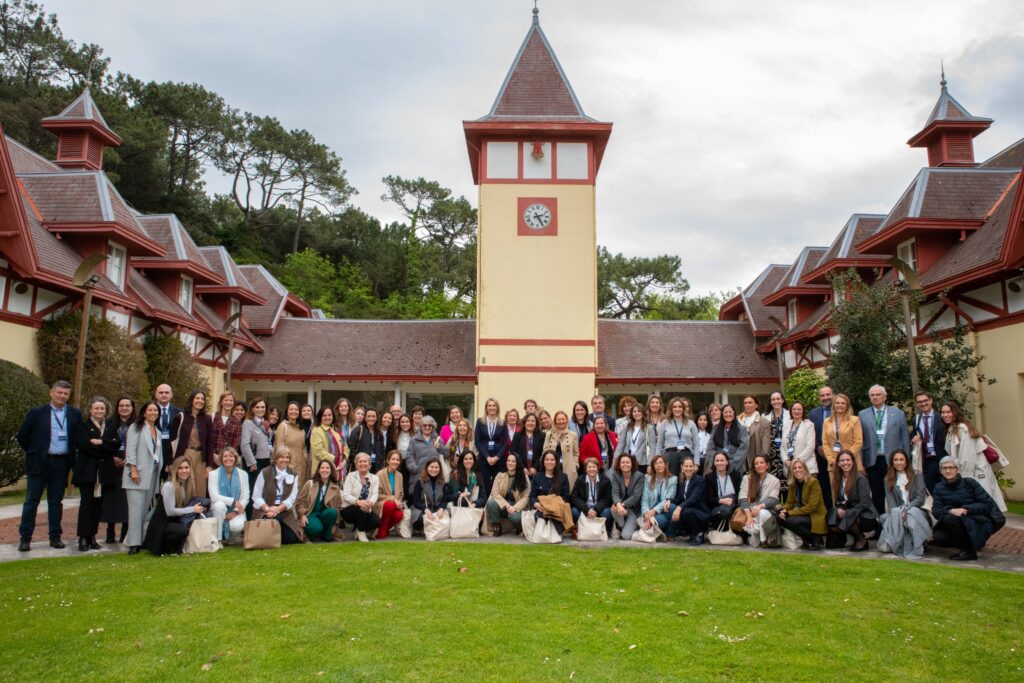
WISTA Spain celebró a finales de abril su Asamblea y Conferencia anual en Santander, bajo el título “Digitalización de la cadena logística, del principio al final del viaje”. (Foto: WISTA – Women’s International Shipping & Trading Association).
WISTA Spain held its annual Assembly and Conference in Santander at the end of April under the title “Digitization of the logistics chain, from the beginning to the end of the journey”. (Photo: WISTA – Women’s International Shipping & Trading Association).
“Aunque afortunadamente cada vez hay más mujeres interesadas en el sector, y ya desde muy jóvenes animadas por sus familias o entornos, sigue habiendo patrones tradicionales a corregir. Hay que evitar que las jóvenes se vean afectadas por los estereotipos mientras deciden su futuro profesional”, argumenta Rosana Velasco, presidenta de WISTA Spain.
Además, frente a la escasez de modelos o referentes femeninos del sector portuario, Velasco propone que todas las mujeres que trabajan en el sector actúen como embajadoras, “contribuyendo a difundir el sector, formando y apoyando a quien tenga interés y, sobre todo, a las mujeres jóvenes que se incorporen. En este sentido, WISTA ha creado un panel internacional de mujeres expertas ponentes y queremos hacer lo mismo a nivel nacional”.
“Although fortunately there are more and more women interested in the industry, and already from a very young age encouraged by their families or environments, there are still traditional patterns to be corrected. We must prevent young women from being affected by stereotypes as they decide their professional future”, argues Rosana Velasco, President of WISTA Spain.
Moreover, faced with the shortage of female role models or references in the port business, Velasco proposes that all women working in the branch act as ambassadors, “helping to spread the word about the industry, training and supporting those who are interested and, above all, the young women who are joining the industry. In this sense, WISTA has created an international panel of expert women speakers and we want to do the same at the national level”.
Translation by Robert Hofman
IMAGEN INICIAL | Mujeres trabajando en la zona portuaria. De izquierda a derecha: Adita Morenilla, patrona de embarcación de prácticos en el Puerto de Cádiz; Susana Bermúdez, la única estibadora del puerto de Cádiz; Judit Soler, estibadora del puerto de Barcelona; y Genoveva Ardana, inspectora de Capitanía Marítima en Cádiz. Fotos: Óscar Cárdenas (APBC) y Coordinadora.
HEAD IMAGE | Women working in the port area. From left to right: Adita Morenilla, patron of the pilot boat in the Port of Cádiz; Susana Bermúdez, the only stevedore in the port of Cádiz; Judit Soler, stevedore at the port of Barcelona; and Genoveva Ardana, inspector of the Maritime Captaincy in Cádiz. (Photos: Óscar Cárdenas – APBC and Coordinadora Estatal de Trabajadores del Mar).